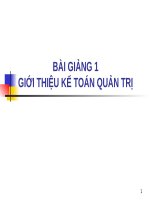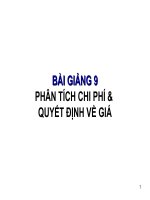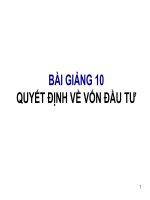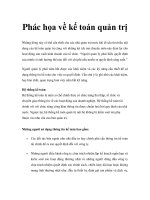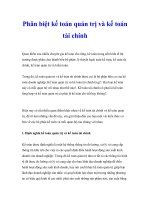ch11 Planning for Capital Investments Ke toan quan tri
Bạn đang xem bản rút gọn của tài liệu. Xem và tải ngay bản đầy đủ của tài liệu tại đây (3.67 MB, 70 trang )
Page
11-1
Standard
Standard Cost
Cost and
and
Balance
Balance Scorecard
Scorecard
Managerial Accounting
Fifth Edition
Weygandt Kimmel Kieso
Page
11-2
study objectives
1.
Distinguish between a standard and a budget.
2.
Identify the advantages of standard costs.
3.
Describe how companies set standards.
4.
State the formulas for determining direct materials and
direct labor variances.
5.
State the formula for determining the total
manufacturing overhead variance.
6.
Discuss the reporting of variances.
7.
Prepare an income statement for management under a
standard costing system.
8.
Describe the balanced scorecard approach to
performance evaluation.
Page
11-3
preview of chapter 11
Page
11-4
The
The Need
Need for
for Standards
Standards
Distinguishing between Standards and Budgets
Both standards and budgets are
predetermined costs, and both contribute to
management planning and control.
There is a difference:
A standard is a unit amount.
A budget is a total amount
Page
11-5
SO 1 Distinguish between a standard and a budget.
The
The Need
Need for
for Standards
Standards
Advantages of Standard Costs
Illustration 11-1
Facilitate management
planning
Promote greater
economy by making
employees more
“cost-conscious”
Useful in setting
selling prices
Contribute to
management control
by providing basis for
evaluation of cost
control
Useful in highlighting
variances in
management by
exception
Simplify costing of
inventories and reduce
clerical costs
Page
11-6
SO 2 Identify the advantages of standard costs.
Setting
Setting Standard
Standard Costs—a
Costs—a Difficult
Difficult
Task
Task
Setting standard costs requires input from all
persons who have responsibility for costs and
quantities.
Standards should change whenever managers
determine that the existing standard is not a
good measure of performance.
Page
11-7
SO 3 Describe how companies set standards.
Setting
Setting Standard
Standard Costs—a
Costs—a Difficult
Difficult
Task
Task
Ideal versus Normal Standards
Companies set standards at one of two levels:
Ideal standards represent optimum levels of
performance under perfect operating conditions.
Normal standards represent efficient levels of
performance that are attainable under expected
operating conditions.
Properly set, normal standards should be rigorous
but attainable.
Page
11-8
SO 3 Describe how companies set standards.
Setting
Setting Standard
Standard Costs—a
Costs—a Difficult
Difficult
Task
Task
Question
Most companies that use standards set them at
a(n):
Page
11-9
a.
optimum level.
b.
ideal level.
c.
normal level.
d.
practical level.
Solution on
notes page
SO 3 Describe how companies set standards.
Page
11-10
Setting
Setting Standard
Standard Costs—a
Costs—a Difficult
Difficult
Task
Task
A Case Study
To establish the standard cost of producing a
product, it is necessary to establish standards for
each manufacturing cost element—
direct materials,
direct labor, and
manufacturing overhead.
The standard for each element is derived from the
standard price to be paid and the standard
quantity to be used.
Page
11-11
SO 3 Describe how companies set standards.
Setting
Setting Standard
Standard Costs—a
Costs—a Difficult
Difficult
Task
Task
Direct Materials
The direct materials price standard is the cost per
unit of direct materials that should be incurred.
Illustration 11-2
Page
11-12
SO 3 Describe how companies set standards.
Setting
Setting Standard
Standard Costs—a
Costs—a Difficult
Difficult
Task
Task
Direct Materials
The direct materials quantity standard is the quantity of
direct materials that should be used per unit of finished goods.
Illustration 11-3
The standard direct materials cost is $12.00 ($3.00 x 4.0 pounds).
Page
11-13
SO 3 Describe how companies set standards.
Setting
Setting Standard
Standard Costs—a
Costs—a Difficult
Difficult
Task
Task
Review Question
The direct materials price standard should
include an amount for all of the following except:
Page
11-14
a.
receiving costs.
b.
storing costs.
c.
handling costs.
d.
normal spoilage costs.
Solution on
notes page
SO 3 Describe how companies set standards.
Setting
Setting Standard
Standard Costs—a
Costs—a Difficult
Difficult
Task
Task
Direct Labor
The direct labor price standard is the rate per hour
that should be incurred for direct labor.
Illustration 11-4
Page
11-15
SO 3 Describe how companies set standards.
Setting
Setting Standard
Standard Costs—a
Costs—a Difficult
Difficult
Task
Task
Direct Labor
The direct labor quantity standard is the time that
should be required to make one unit of the product.
Illustration 11-5
The standard direct labor cost is $20 ($10.00 x 2.0 hours).
Page
11-16
SO 3 Describe how companies set standards.
Setting
Setting Standard
Standard Costs—a
Costs—a Difficult
Difficult
Task
Task
Manufacturing Overhead
For manufacturing overhead, companies use a
standard predetermined overhead rate in
setting the standard.
This overhead rate is determined by dividing
budgeted overhead costs by an expected
standard activity index, such as standard direct
labor hours or standard machine hours.
Page
11-17
SO 3 Describe how companies set standards.
Setting
Setting Standard
Standard Costs—a
Costs—a Difficult
Difficult
Task
Task
Manufacturing Overhead
The company expects to produce 13,200 gallons during
the year at normal capacity. It takes 2 direct labor hours
for each gallon.
Illustration 11-6
Standard manufacturing overhead rate per gallon is
$10 ($5 x 2 hours).
Page
11-18
SO 3 Describe how companies set standards.
Setting
Setting Standard
Standard Costs—a
Costs—a Difficult
Difficult
Task
Task
Total Standard Cost Per Unit
The total standard cost per unit is the sum of the
standard costs of direct materials, direct labor, and
manufacturing overhead.
Illustration 11-7
The total standard cost per gallon is $42.
Page
11-19
SO 3 Describe how companies set standards.
Setting
Setting Standard
Standard Costs—a
Costs—a Difficult
Difficult
Task
Task
Ridette Inc. accumulated the following
standard cost data concerning product Cty31.
Materials per unit: 1.5 pounds at $4 per pound.
Labor per unit: 0.25 hours at $13 per hour.
Manufacturing overhead: Predetermined rate is 120% of
direct labor cost.
Compute the standard cost of one unit of product Cty31.
Page
11-20
Solution on
notes page
SO 3
Page
11-21
Analyzing
Analyzing and
and Reporting
Reporting Variances
Variances
From
From Standards
Standards
One of the major management uses of standard
costs is to identify variances from standards.
Variances are the differences between total
actual costs and total standard costs.
Page
11-22
SO 3 Describe how companies set standards.
Analyzing
Analyzing and
and Reporting
Reporting Variances
Variances
Question
A variance is favorable if actual costs are:
Page
11-23
a.
less than budgeted costs.
b.
less than standard costs.
c.
greater than budgeted costs.
d.
greater than standard costs
Solution on
notes page
SO 3 Describe how companies set standards.
Analyzing
Analyzing and
and Reporting
Reporting Variances
Variances
When actual costs exceed standard costs, the
variance is unfavorable.
When actual costs are less than standard costs, the
variance is favorable.
To interpret properly the significance of a variance,
you must analyze it to determine the underlying
factors. Analyzing variances begins by determining
the cost elements that comprise the variance.
Page
11-24
SO 3 Describe how companies set standards.
Analyzing
Analyzing and
and Reporting
Reporting Variances
Variances
Illustration: Assume that in producing 1,000 gallons of
Weed-O in the month of June, Xonic, Inc. incurred the
following costs.
Illustration 11-8
The total standard cost of
Weed-O is $42,000 (1,000
gallons x $42). Thus, total
variance is $2,500.
Page
11-25
Illustration 11-9
SO 4 State the formulas for determining
direct materials and direct labor
